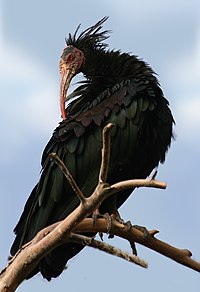
Photo from wikipedia
The critically endangered Northern bald ibis (Geronticus eremita) is a migratory bird that became extinct in Europe centuries ago. Since 2014, the Northern bald ibis is subject to an intensive… Click to show full abstract
The critically endangered Northern bald ibis (Geronticus eremita) is a migratory bird that became extinct in Europe centuries ago. Since 2014, the Northern bald ibis is subject to an intensive rehabilitation and conservation regime aiming to reintroduce the bird in its original distribution range in Central Europe and concurrently to maintain bird health and increase population size. Hitherto, virtually nothing is known about the microbial communities associated with the ibis species; an information pivotal for the veterinary management of these birds. Hence, the present study was conducted to provide a baseline description of the cultivable microbiota residing in the Northern bald ibis. Samples derived from the choana, trachea, crop and cloaca were examined employing a culturomic approach in order to identify microbes at each sampling site and to compare their frequency among age classes, seasonal appearances and rearing types. In total, 94 microbial species including 14 potentially new bacterial taxa were cultivated from the Northern bald ibis with 36, 58 and 59 bacterial species isolated from the choana, crop and cloaca, respectively. The microbiota of the Northern bald ibis was dominated by members of the phylum Firmicutes, followed by Proteobacteria, Actinobacteria, Bacteroidetes and Fusobacteria, altogether phylotypes commonly observed within avian gut environments. Differences in relative abundances of various microbial taxa were evident among sample types indicating mucosa-specific colonisation properties and tissue tropism. Besides, results of the present study indicate that the composition of microbiota was also affected by age, season (environment) and rearing type. While the prevalence of traditional pathogenic microbial species was extremely low, several opportunists including Clostridium perfringens toxotype A were frequently present in samples indicating that the Northern bald ibis may represent an important animal reservoir for these pathogens. In summary, the presented study provides a first inventory of the cultivable microbiota residing in the critically endangered Northern bald ibis and represents a first step in a wider investigation of the ibis microbiome with the ultimate goal to contribute to the management and survival of this critically endangered bird.
Journal Title: PLoS ONE
Year Published: 2018
Link to full text (if available)
Share on Social Media: Sign Up to like & get
recommendations!